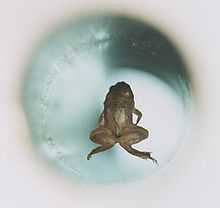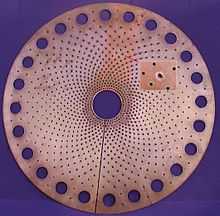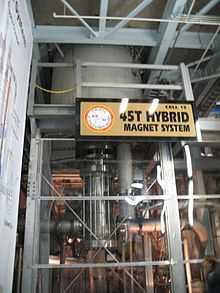Bitter electromagnet

A Bitter electromagnet or Bitter solenoid is a type of electromagnet invented in 1933 by American physicist Francis Bitter used in scientific research to create extremely strong magnetic fields. Bitter electromagnets have been used to achieve the strongest continuous manmade magnetic fields on earth (up to 45 teslas - as of 2011).
Advantages
Bitter electromagnets are used where extremely strong fields are required. The iron cores used in conventional electromagnets saturate and cease to provide any advantage at fields above a few teslas, so iron core electromagnets are limited to fields of about 2 teslas. Superconducting electromagnets can produce stronger magnetic fields but are limited to fields of 10 to 20 teslas, due to flux creep, though theoretical limits are higher. For stronger fields resistive solenoid electromagnets of the Bitter design are used. Their disadvantage is that they require very high drive currents, and dissipate large quantities of heat.
Construction

Bitter magnets are constructed of circular metal plates and insulating spacers stacked in a helical configuration, rather than coils of wire. The current flows in a helical path through the plates. This design was invented in 1933 by American physicist Francis Bitter. In his honor the plates are known as Bitter plates. The purpose of the stacked plate design is to withstand the enormous outward mechanical pressure produced by Lorentz forces, which increase with the square of the magnetic field strength. Additionally, water circulates through holes in the plates as a coolant, to carry away the enormous heat created in the plates due to resistive heating by the large currents flowing through them. The heat dissipation also increases with the square of the magnetic field strength.
Record Bitter magnets

The strongest continuous magnetic fields on Earth have been produced by Bitter magnets. As of 31 March 2014 the strongest continuous field achieved is 37.5 T produced by a Bitter electromagnet at the Radboud University High Field Magnet Laboratory in Nijmegen, the Netherlands.[1]
In 2014, the construction of a Bitter magnet with a maximum field strength of 38.0 T will be finished in the Radboud University High Field Magnet Laboratory in Nijmegen.[2] This system will consume 17 Megawatts of electricity at maximum field strength.
The strongest continuous manmade magnetic field, 45 T, was produced by a hybrid device, consisting of a Bitter magnet inside a superconducting magnet.[3]
See also
References
- ↑ "HFML sets world record with a new 37.5 tesla magnet". High Field Magnet Laboratory. 31 March 2014. Retrieved 21 May 2014.
- ↑ "High Field Magnet Laboratory - Magnet specifications". High Field Magnet Laboratory (Radboud University). Retrieved 2013-12-20.
- ↑ Coyne, Kristin (2008). "Magnets: from Mini to Mighty". Magnet Lab U. National High Magnetic Field Laboratory. Retrieved 2008-08-31.
External links
- National High Magnetic Field Laboratory Magnet Projects Page at Florida State University
- Magnets at Nijmegen High Field Magnet Laboratory
- The Frog That Learned to Fly and a ball of water inside a Bitter solenoid at the High Field Magnet Laboratory
- Diagrams and description of the Bitter solenoid used in the frog levitation demonstration
- Bitter magnet designs: NHMFL Bitter Magnet and Radbound University Bitter Solenoid